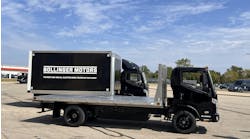INDIANAPOLIS. Industry anticipation, and growing concern, is building as the release of the official proposed EPA Phase II regulations grow closer. Attendees at the Green Truck Summit here in Indy received a general outlook at what the EPA is looking towards when those rules are released “this spring,” according to Matthew Spears, center director of heavy-duty diesel programs for the Environmental Protection Agency.
“A lot of the work we’ve been doing in the last couple of years has been on the technical side on what technologies may be needed,” he said during a panel discussion. Spears noted that the EPA has a relatively large list of possible technologies that it is looking at in meeting the goals.
“There are a number of factors that go into which technologies to consider for specific applications,” he said, showing a slide with some of the possibilities.
For engine technologies, they include:
- Coolant pumps
- Engine downsizing
- Down-speeding
- Engine friction reduction
- Improved SCR
- Lower friction engine oil
- Stop-star technology
- Variable valve timing
In regards to vehicle and trailer technologies, Spears listed:
- Automated manual transmissions
- Automatic tire control
- Battery auxiliary power units
- Cab insulation
- Driver coaching features
- Aerodynamic improvements
- Low rolling resistant tires
- Manual transmissions
- 6x2 tractor axles
- Weight reductions
Not all technologies will work in every application, Spears noted, and that is what EPA and industry stakeholders have been working to identify.
“We really try our best to do a significant amount of stakeholder outreach,” Spears said. “I’m really happy we’ve been able to reach out to so many to help make [Phase I] regulations work for this segment.”
To echo that point, Brian Mormino, executive director of worldwide environmental strategy and compliance for Cummins Inc., handed out a few words of praise for EPA’s handling of the Phase I regulations.
“We need to build on the success of Phase I,” he said. “You don’t often hear people stick up for EPA as I’m going to do a little here, but I think they got it mostly right. How do I know? Because we had Phase I go into effect in 2014 and nobody really knew.”
Spears went on to add that the Phase II regulations would look at new technologies, “beyond off-the-shelf” solutions, trailers and other criteria. But, most importantly, the regulations will really take a look at the whole vehicle.
And that point is what a couple of the other members of the panel addressed.
Alexander Freitag, director of diesel system engineering for component supplier Robert Bosch, noted that no longer would components be able to be built individually without regard to how they interact with other components.
“There is going to be a change in approach … to a total system approach,” he said. “Components need to work with other components rather than [separately] in a vacuum.
Still, there are concerns as EPA readies its proposal. Michael Hayn, senior field engineer-central region, for Bridgestone Americas, pointed out possible impacts on tires.
“Phase II, to my understanding, will include trailers and add-on technologies,” he said. “We do have some concerns with those add-ons and their impact on tires. Will Phase II impact tires? Yes, both directly and indirectly.”
Among the concerns Hayn noted are the possibility of increased heat within tires as “gaps are narrowed.” Also, tire maintenance may be impacted as more aerodynamic devices are placed on vehicles, making routine maintenance more labor-intensive.
Amy Kopin, compliance and regulatory affairs for Daimler Trucks North America, brought to light other concerns.
“We don’t want to see complex, expensive technology forced on the market, especially if it affects vehicle weight and fuel economy,” she said.
Kopin added that the hope of DTNA was the EPA would build upon the Phase I regulations and not create separate engine regulations, as some “environmental groups, who are on their second round of letter-writing campaigns, want.”
If separated, that approach could potentially add $35,000 to $40,000 to the cost of a vehicle, she said. By taking a whole vehicle approach, including the engine, OEMs could take advantage of integrated powertrains in helping meet the regulations.
Kopin also said the hope was that the regulations would have a “limited impact” on the vocational market.


